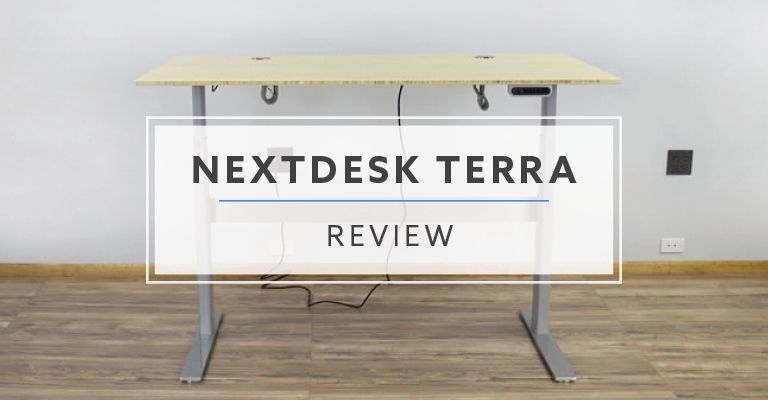6/10/20 Update: District Judge William M. Conley dismissed the case against us. You can read more here BTOD Lawsuit: Case Dismissed Next Technologies Inc. v. Beyond The Office Door, LLC
5/14/20 Update: If you’ve been following our brand, you may or may not have seen that we were in a lawsuit with a company called Next Technologies based in Georgetown, TX. This is the parent company for both EvoDesk and Xdesk, formally named NextDesk. At the direction of our counsel, we haven’t really addressed this lawsuit publicly. But unfortunately, because of their continued attacks on our business and me personally, we thought it was important we cover five of the main areas that they’ve outlined on their website, what they call “BTOD Exposed.” In the video below we cover the Xdesk Terra and show you how the claims they are making against us are false.
Today we are taking a closer look at the Xdesk Terra, a product that was once dubbed the “best standing desk” by TheWireCutter. It held its position for multiple years, leading to rapid growth for a company that was founded in 2012. The Xdesk Terra is their flagship product and based on their own marketing it is still the “Gold Standard” in electric standing desks. With so much hype, I have been looking forward to the opportunity to testing this product. Let’s take a closer look at what I found during the process.
Need help? Get our Free Electric Standing Desk Buying Guide!
Full Disclaimer: We are an office furniture dealer and sell some of the products we review. To learn more about the products we sell, our review process and why you can trust us, please visit: Why we’re different. Who is BTOD.com and The Breakroom Blog?
NextDesk Terra Review Snapshot
Pros
- High quality electronics pack
- Premium gears and glides
- 5 year warranty on electronics
- Quick and easy assembly
Cons
- High price tag
- Stability issues at all heights
- Mismatched colors for frame
- No overload protection
- No anti collision system
- Adjustable foot glides $100
OEM Manufacturer
The major OEM manufacturer for the Xdesk Terra is Linak. They provide the columns and all electronic components for the Xdesk. Linak was founded in 1907 as a flat and V-belt manufacturer. Changes to management in 1976 would ultimately bring Bent Jensen on as CEO and owner of Linak. He would later introduce his first linear actuator in 1979. By 1986 Linak added an electronics department to produce their control boxes. Over the last 38 years, Linak has positioned themselves as one of the leading suppliers for high quality linear actuator systems and control box mechanisms. Because they only produce the columns and electronics, companies that use them for a supplier are required to produce their own feet and desktops.
Xdesk Terra Review Links
– Specs / Pricing / Features
– Assembly Process
– Stability Testing
– Electronics
– Column, Foot and Frame
– Motor and Gears
– Glide Systems
– Testing The Specs
– What I Like
– What I Don’t Like
– Final Thoughts
Xdesk History
Xdesk was founded by Dan Lee and Jamie Fertsch, with a goal to create a beautiful standing desk. According to Dan Lee, while standing desks have been available for a long time, they were slow, loud and made from particle board. Both he and Jamie were determined to create something with better performance and materials, which ultimately ended up being the Xdesk Terra.
Product Specs (per Xdesk.com)
Height Adjustment Range: 24 to 50.5”
Travel Speed: 1.7”
Weight Capacity: 315 lbs.
Adjustable Foot Glides: n/a
Noise Level: 60 dB
Pricing
$1,693.00 + $137 (shipping) = $1,830.00
Options selected: 31.5” x 63” Light Bamboo, Silver Gloss (+$97), Six Leveling Pads (+$99)
Features (per Xdesk.com)
Push-button power adjustable height selection
Dual microprocessor controlled lifting columns
Dual powerful 18 volt DC motors
3 Programmable memory presets
Unibody construction: out of sight internal motor design
15 feet of NextFlex™ braided monofilament cable cover contains power and data cables
Packaging
The Xdesk Terra ships with a freight carrier on a large pallet. It is inside protected inside a typical cardboard box, but the sides are reinforced with plywood. Over the top of the box is an additional piece of plywood. Inside the Xdesk’s box, all of the individual parts are wrapped in plastic and/or foam padding. Looking inside the box, you can see there is a lot of opportunity for parts to slide around. I was a little surprise that Xdesk let the Terra parts to freely move. Almost everything arrive to our office is good condition, with the only exception being one of the aluminum feet. It had a bend that didn’t allow it to lay flat on the floor. Xdesk did send out a replacement, something we will talk more about that later in the review.

Assembly
The assembly process for the Xdesk Terra was straightforward. They shipped the desk with the upper supports, control box and switch already attached. This only left you with attaching the columns to the upper supports and feet. You then had to flip the table upright, raise it slightly and attach the cross support. The traditional cross support is attached with an interlocking wedge system that requires a rubber mallet to pound into place. Altogether the process only took about 30 minutes. The UpDesk Elements also featured Linak columns and the process was very similar. I’m not sure if this is a recommendation from Linak or just coincidence. Regardless, the Xdesk assembly was one of the easiest I have completed to date.
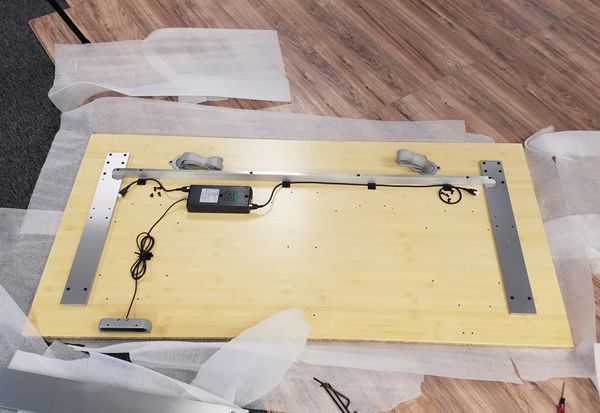
See The Best Electric Standing Desks For 2020After months of testing 20+ electric sit stand desks, the results are in! |
Xdesk Terra Stability
The Xdesk Terra is the fourth desk I have reviewed with a traditional cross support. The VertDesk v3, GeekDesk v3 and StandDesk Simple all included traditional cross supports as well. Having a stable standing desk is one of the most important aspects of this type of product. When your desk has stability issues there is a high likelihood it will impact your work efficiency. My stability tests always include the two of the most common motions on a standing desk. The first is a left to right wobble test and the second is the front to back rocking test.
Left to Right: Because the Xdesk Terra features a traditional cross support, the lateral stability on it was very good. In fact, this was the first desk that we’ve tested that goes beyond 47.5” tall that remained solid through almost 49” tall. Beyond 49” there was a slight amount of sway. This motion was consistent through 51” tall and wouldn’t likely impact your work.
Front to Back: Unfortunately, the strong performance in the wobble test didn’t transfer to the rocking test. The desk had rocking motions that started as early at 28” tall, which is a height that most users would sit. Once the desk rose beyond 38” the motion was significant and would impact your work. At this height, users that are 5’2” and above would be affected.
Reason for Stability Issues
The front to back rocking test showed signs of stability issues as early as 28” tall. It was important for me to take a closer look at the reason why, especially with a price tag over $1700. Looking closer at where the movement originated, you could actually see the aluminum feet flexing. Because Xdesk chose to use solid aluminum for the feet on the Terra, there was a lack of structural rigidity found in the foot. The flexing in the foot created stability problems at all heights.
It’s clear in my opinion that Xdesk is aware of this issue. I know this because of their use of three glide pads per foot. The same thing is required when casters are used, with a caster require on both ends of the foot and in the middle. This is the first desk that has required three glide pads. When I tested the desk without, the foot actually sagged in the middle from the weight of the frame and desk top.
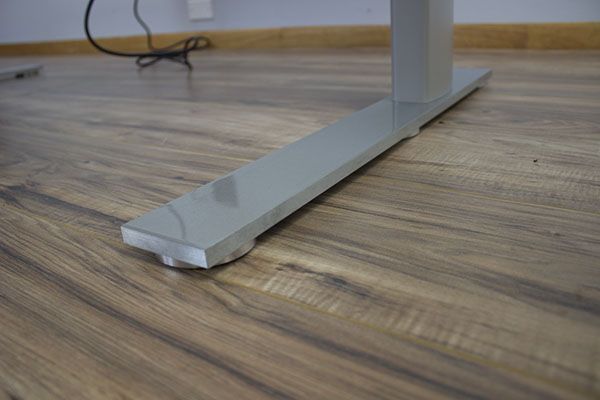
Note: As I mentioned in all of my reviews, you have to make sure to fully tighten all hardware. As standing desks become extended the motion will become exaggerated. If your hardware is loose, your standing desk will have bad wobble and rocking motions.
Electronics
The Xdesk Terra features a CBD6S smart control box from Linak electronics. This is the most compact control box from the Linak DESKLINE series. At only 38 mm high and 210 mm long, it is small enough to fit within most desk frames. The control box design is more intuitive that most, with motor plugs on both sides of the control box. This allows for less wire to be used when stretching from the columns to the control box.
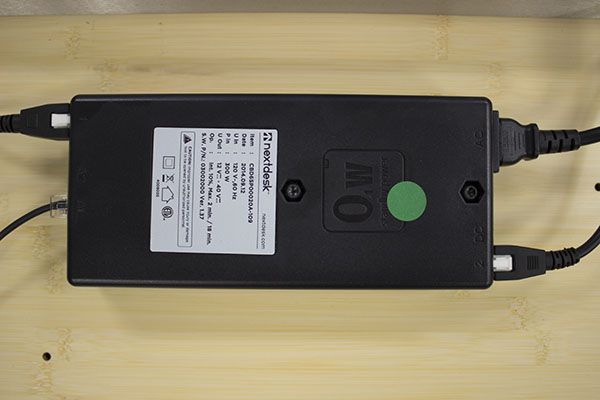
The CBD6S control box system features very low power consumption when in standby mode. At only .1w, the CBD6S is one of the most energy efficient control boxes available.
Opening the control box to take a closer look at the circuit board, I was happy to see a single board. The Linak CBD6S’s board was made specifically for this series and was impressive. There weren’t poorly wrapped toroid cores or excessive use of glues and epoxies. Unlike all of their Chinese competitors, the Linak system was as close to perfection as you will find.
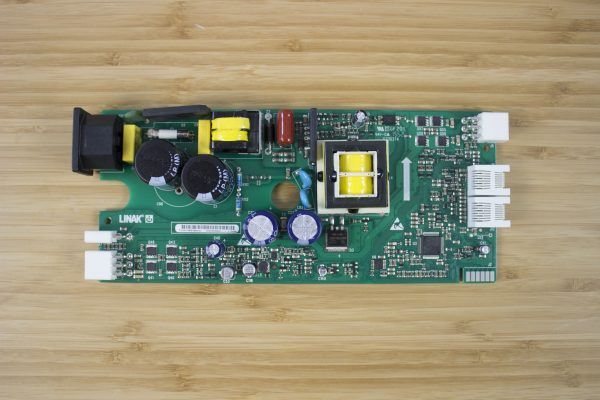
Unfortunately, with all of the positives the CBD6S has going for it there were some misses. The first was the lack of overload protection available in the Xdesk Terra. With a max weight capacity of 1400 Newton’s (314.73 lbs), the Xdesk Terra should shut down to protect internal gears when that weight rating is exceeded. I was able to overload the desk and lift 360 lbs., which is significantly overweight.
The second miss is linked to the anti-collision avoidance system. Through testing, I found the Xdesk Terra didn’t include this function. To me this was surprising, since it is offered on desks that are one third the cost.
Column, Foot and Upper Frame Build Quality
Taking a closer look at the frame, it’s important to separate the columns from the rest of the frame components. The columns are manufactured by Linak and the remainder of the frame by Xdesk.
I ordered the Silver Gloss aluminum frame finish (+$97), assuming that this would be the color of the entire frame. What Xdesk fails to inform its customers are that the columns of the desk are actually made from steel. The steel is powder coated in three colors; silver, white or black finish. The additional frame pieces made by Xdesk, for the Terra, are made from aluminum. Because of this, they do not match the columns and in my case they weren’t even close.
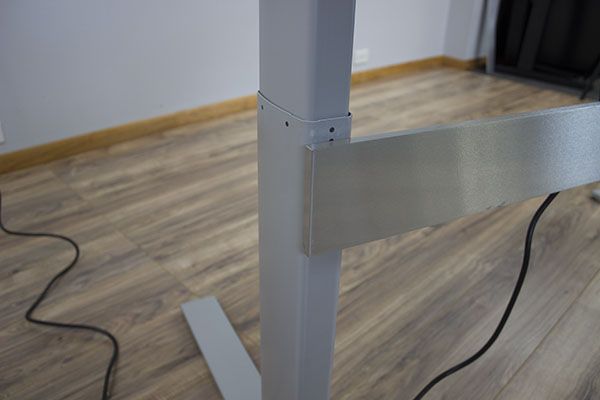
This was misleading, since all of their marketing material touts recycled aluminum frames. When I reached out to Xdesk, they only reiterated the fact that their columns are in fact aluminum. Even after challenging them and telling them it was a steel Linak DL4S column, they refused to come off the aluminum story. Only after multiple phone calls and chats was I able to get the correct answer. Clearly there is significant confusion at the company, which is surprising since they claim to be the manufacturer of the product. My biggest concern is that they continue to mislead customers, with the same bad information shown on their site since our call in early September.
The Xdesk Terra features the DL4S column, formerly manufactured as the DL4 column. This Linak column features a semi rounded look on what would otherwise be a rectangle shaped column. When I think of Linak, this is the column that always comes to mind. As with all Linak columns, the paint finish on the column was consistent and well done. We ordered the silver finish, which shows the seam in the steel tubing quite a bit more than the black DL5 column we have from the UpDesk Elements. Overall, I have noticed that the Linak product doesn’t do as good of a job hiding their seams and with silver paint it was even more apparent. Because of the glide design used on the DL4S column, there is a fairly significant gap between each of the columns. This is normally filled with plastic covers or a glide that is shaped like a collar around the interior sections of the columns.
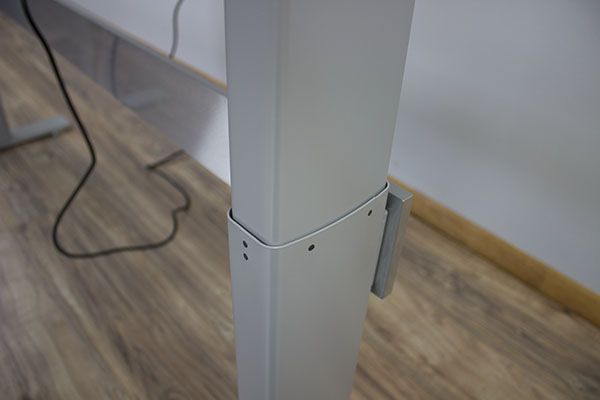
The use of solid aluminum for the foot and frame design left me uninspired. Even looking beyond the mismatched colors, solid aluminum isn’t as stable as molded aluminum or a formed piece of steel. This issue goes beyond just the foot design, as the upper desk top supports are also made from the same solid aluminum. The only good use of aluminum is in the cross support. Because it is flipped on its side, the height of the aluminum actually provides the required lateral stability to reduce wobble.
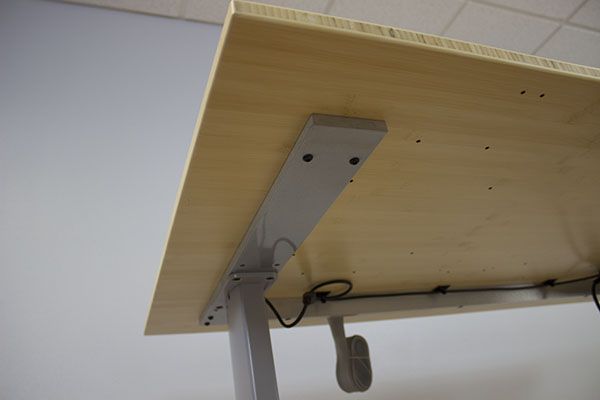
While I found the design of the cross support to be adequate, the design of the mounting brackets was still an issue. Over the time I tested the Xdesk Terra, I noticed the desk would begin to show signs of wobble. Looking closer at the cross support, I found that it was coming from the wedge brackets used to attach the cross support to the column. After pulling the cross support off, I could tell these brackets were loosening from the natural movement and vibrations of the desk. Pulling the brackets off, I was surprised to find the hardware didn’t include any type of thread locker like Loctite or a locking washer. Without these, the bolts will continue to loosen and require constant retightening.

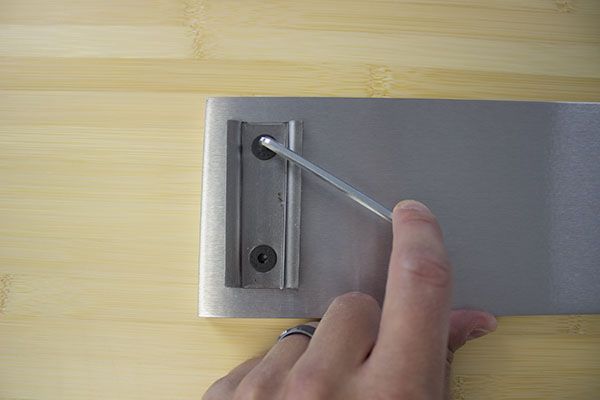
Gear and Motor System
The Xdesk Terra features a Linak gear and motor system. Known globally as a leader in high quality linear lifting systems, the gear and motor system on the Terra was no exception. One thing I found interesting was that Xdesk again featured bad information on their website. All of their marketing material talked about a dual chain drive system and even showed line drawings of these internal components. After pulling apart the columns, I was able to confirm the current DL4S system featured a spindle gear drive. After the frame material debacle, there was no point in reaching out to Xdesk to have them confirm this. At this point it was fairly obvious they don’t know much about the product they sell.
After opening the columns I was able to pull out the gear and motor system. The gear and motor were actually attached, with the motor placed completely in line with the gear system. This was the first motor that I have seen attached to the top of the gear in such a way. It created a very slim system that enabled Linak to eliminate the typical motor boxes found at the top of a column.

The motor attached to the gear with a simple twist and click system. The DL4S motor is completely enclosed, which helps to keep out contaminants such as dust and dirt out of this important system. Taking the motor off, it appeared to be very simple with a single gear. I knew this couldn’t be the case, there had to be more to it. As I pulled it apart layer by layer it continued to become more complex. In total, there were five gears inside the encasement, plus the worm drive attached to the motor. It is one of the most interesting systems I have come across. Through this gearing system, Linak is able to produce the speeds required to move the DL4S at their preferred speed of 1.49” per second.
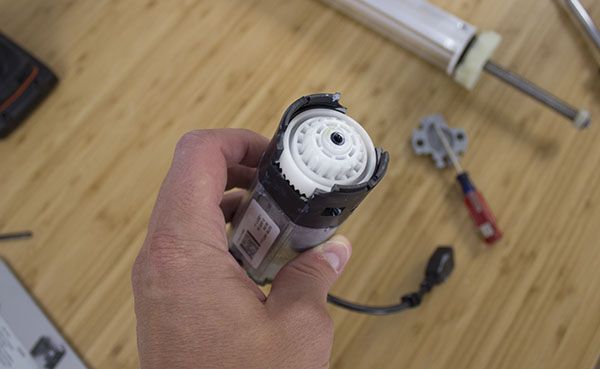
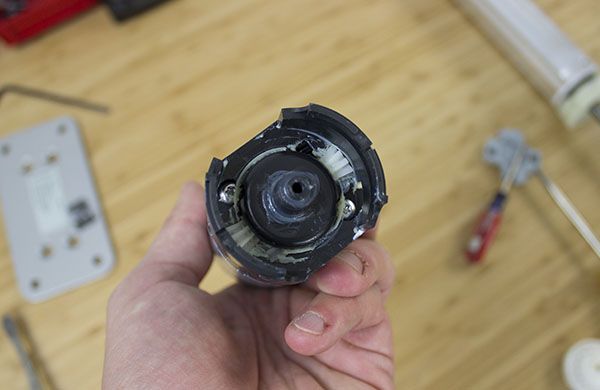

The second portion was the gear system. It was a two stage gear that provided the Xdesk Terra with almost 26” of travel. Something different about this particular gear was that it all pushed out the bottom. All of the other two stage gears I have reviewed prior to this, remained constant in the middle, pushing out of both the top and bottom.

The gear itself was nice and on par with all of the other high quality gears I have reviewed. There weren’t issues with overly greased components, like what is found on most Chinese products. The middle section of the gear that was load bearing included a nylon component that was much improved from the cheap plastics found on the JieCang products. My only concern was that this part was held in place in two small notches in the column with only a small amount of material holding it in place.

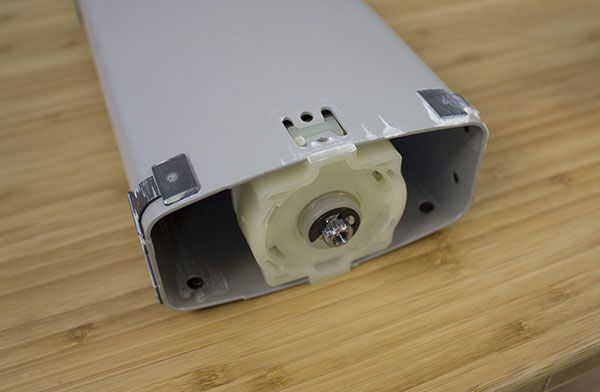
Glide System
The glide system on the Xdesk Terra was really good. Again, this setup was different from what I’ve found on others. It included three sets of glides per column, with two sets on the bottom third and one of the top. This was likely for additional stability within the columns. Based on my testing, it worked as the columns had a nice solid feel.
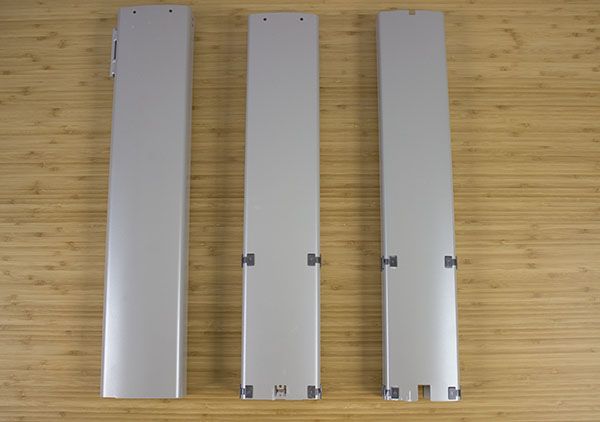
The material used on the glides was as expected, Delrin acetal from Dupont. This is the same material used on the Linak DL5 column found on the UpDesk Elements. Delrin is a high quality plastic that creates a natural lubricating glide which is extremely durable. We use the same material on our VertDesk v3 and through cycle testing found it held up very well over high cycle counts.
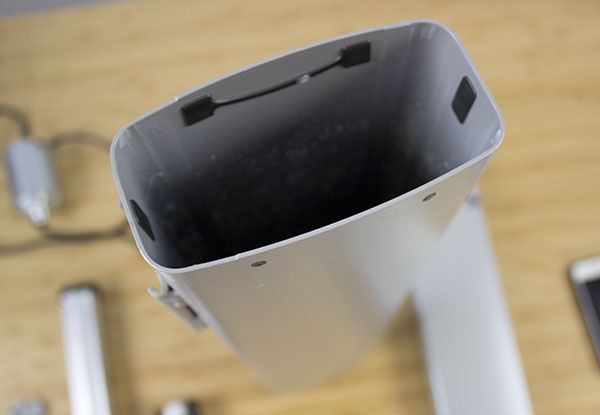
Because this type of material is used for the glides, minimal amounts of lubricant are required to allow the columns to slide up and down. This creates a much cleaner experience and reduces the chances for binding in the columns that is commonly found with cheaper plastics. Because Delrin wears well over high cycle counts, the fit between the columns remains consistent over the life cycle of the frame.
Wire Management
The NextDesk Terra comes with built in vertical wire management. They have named this NextFlex™, which is a braided monofilament cable designed to house power and data cables. These are tied into brackets which are mounted to the bottom of the desk surface to provide a nice finished look.
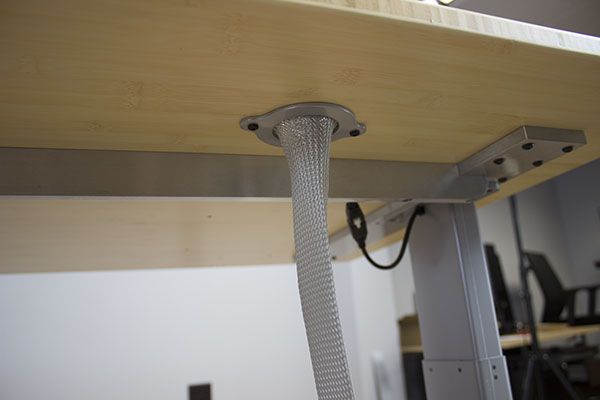
At first, these looked like a really nice feature. Unfortunately, they had two glaring issues. The first was that it was difficult to run multiple power cords down the same cable. With more than one cable, they would get stuck on the braiding and was very difficult to push the second wire through. The second problem, they only work for wires the originate on the top of the desk. The most obvious wire that I wanted to hide was the power cord for the desk itself. There wasn’t a way to access wire management since the power cable is underneath the desk surface.
Warranty
The NextDesk Terra is covered under a five year limited warranty. This warranty covers the electronics and structural components of the desk. This does not cover misuse, abuse, negligence, alteration or tampering.
Testing the Specs
Height Adjustment Range: 24” to 50.5”
True. The range was as specified on Xdesk.com.
Adjustment Speed: 1.7”
False. I’m not sure where Xdesk came up with this number. The OEM Linak lists a speed of 38 mm/s (1.496”/ second) and during my testing with only the top I averaged 1.48” per second.
Noise Level: 60 dB
True. I found that the Xdesk Terra averaged between 58-60 dB in transition. This noise level is about average for the electric standing desk category.
Weight Capacity: 315 lbs.
True. The max weight capacity per the OEM manufacturer is 1400 Newtons (314.73 lbs). During testing I found the desk was able to exceed 315 lbs. With 360 lbs. the NextDesk Terra’s speed dropped from 1.48” per second to .96” per second. The Terra does not come with overload protection.
What I Like About the Xdesk Terra
Premium Gears and Glides
Xdesk made a wise decision by partnering with Linak for their desk columns. Linak is known around the globe for producing some of the highest quality gears available. The level of craftsmanship is obvious as you move the gears manually with your hands. Pair this with glides that are made from Delrin acetal plastics and you have a frame that is built to last. Lower quality plastics have proven to wear faster, which over time will decrease a standing desks stability.
High Quality Electronics
After opening as many control boxes as I have over the past nine months, the difference between good and bad electronics has become clear cut. While the Xdesk Terra’s electronics are made in China, the factory they are manufacturer in has a much higher standard of quality control. The first noticeable difference with their control box is the single board that was designed specifically for the CBD6S control box. Looking closer at the board itself, there isn’t an excessive use of caulk or epoxy to set their electronic components. When compared to other control box made in China, the Linak product is on another level of quality.
5 Year Warranty on Electronics
While a five year warranty on electronics isn’t leading the pack, it is still above average. Five years is the best we have found from the premium electronics providers in the industry.
Quick and Easy Assembly
The Xdesk Terra was one of the easiest desks I have assembled to date. The desk arrived with the upper supports, control box and switch preassembled. All I needed to do was attach the columns, feet and cross support . Total time required is about 30 to 60 minutes with the allen wrench included.
What I Don’t Like About NextDesk Terra
Stability Issues at all Heights
The Xdesk Terra was one of the oddest tables I have tested for stability. It has so many things going right for it that it should have been a shoo-in as one of the most stable standing desks. It has Linak columns with three sets of glides per column, a traditional cross support and an additional support bar underneath the desk surface. Unfortunately, the decision to use solid aluminum feet and worksurface supports created an awkward flex for the front to back rocking test. It was so bad that the desk showed signs of rocking as early as 28” tall.
Mismatched Colors For the Frame
The decision to go with the high gloss silver finish for the frame ended up backfiring on me. With a matte finish on the powder coated steel column, the high gloss cross support and feet looked out of place. At $1,800, this is not something I would have expected to end up with. I think it should be noted on the website they do not match. If you buy a Xdesk Terra, do not upgrade to the more expensive finishes. Stick to the stand matte finishes as they are more likely to match the Linak painted column.
Vertical Wire Management
The vertical wire management included with the Terra had really good potential. Unfortunately, the NeatFlex wire management came short though; mostly because it was impossible to run multiple power cords down the monofilament cable. To make matters worse, there isn’t a way to access the wire management for wires that are underneath the desk top. This included the power cord for the desk, which felt odd having it exposed with two cable management system on either side.
No Overload Protection or Anti Collision
It is a little odd to me that Xdesk Terra doesn’t have an overload protection or anti-collision system with the Terra series. With a price of $1,800, it is one of the most expensive options on the market. Desks that cost a third of the price include these functions as standard features. Considering the warranty doesn’t cover abuse, my concern is if you overload the desk and then something breaks, is that covered under the warranty, or would you have to pay to fix it? For this price, I would hope it had safety systems in place to prevent this type of human error from occurring.
Lack of Thread Locker or Star Washers Used
During my testing of the Terra, I found that the cross support would continue to loosen over time. With a closer inspection, I found that the screws that held the wedge system (used to connect to the columns) in place were slowly loosening. While this only created a little bit of movement in the cross support, it created a lot of wobble movement for the desk. Without the use of a thread locker such as Loctite or a locking washer, there is no way to prevent this.
Adjustable Foot Glides Extra $100
When I first ordered the desk, I didn’t realize it came without adjustable foot glides. The desk arrived and only after started to assemble the desk did I notice this. This meant if I was on carpet or had an uneven floor the desk would instantly have stability issues. Jumping back onto the Xdesk.com website, I searched and found them. $100 for adjustable foot glides, something that literally comes standard on every single table I have reviewed.
I called Xdesk to request a replacement foot since one of mine was bent. While on the call I requested the glides as well. They threw them in at no charge. I am grateful for that; however, I’m not sure if that is standard procedure or if it was because they knew I was reviewing the desk. Either way, I highly recommend them if you want your desk to be somewhat stable.
High Price Tag
While I understand why nice things generally cost more, the Xdesk Terra takes that to another level. The use of the CBD6S control box and DL4S column from Linak drives the cost up, which is completely worth it. The problem I have is with the excessive amount of solid aluminum used throughout the frame. Not only does this drive the cost up, but it creates stability issues at all heights. If it would have improved stability, then the additional cost would make more sense to me. To top it off, adding adjustable foot glides will cost you an extra additional $100. While the Xdesk Terra is nice, it is not a good value by any means.
Final Thoughts
Having previously reviewed desks that were anywhere from $300 up to $1000, my expectations for the $1,800 Xdesk Terra were pretty high. I should know by now that having such high expectations generally leaves you with a big letdown. That again was the case with the Xdesk Terra. It’s unfortunate, as I had genuinely hoped it would prove to be a stable desk. I have been trying to write a “top list” for stability post and it has been difficult to find good products for it. Unfortunately, the Terra ended up being one of the least stable standing desks I have tested. This was in large part due to solid aluminum feet and upper supports that flexed when the desk rocked back and forth. While the Xdesk Terra still features one of the best electronics packages, with premium the gears and motors, it isn’t worth the high price tag. There are plenty of alternatives available in the mid-range that will offer similar components for half the cost.


